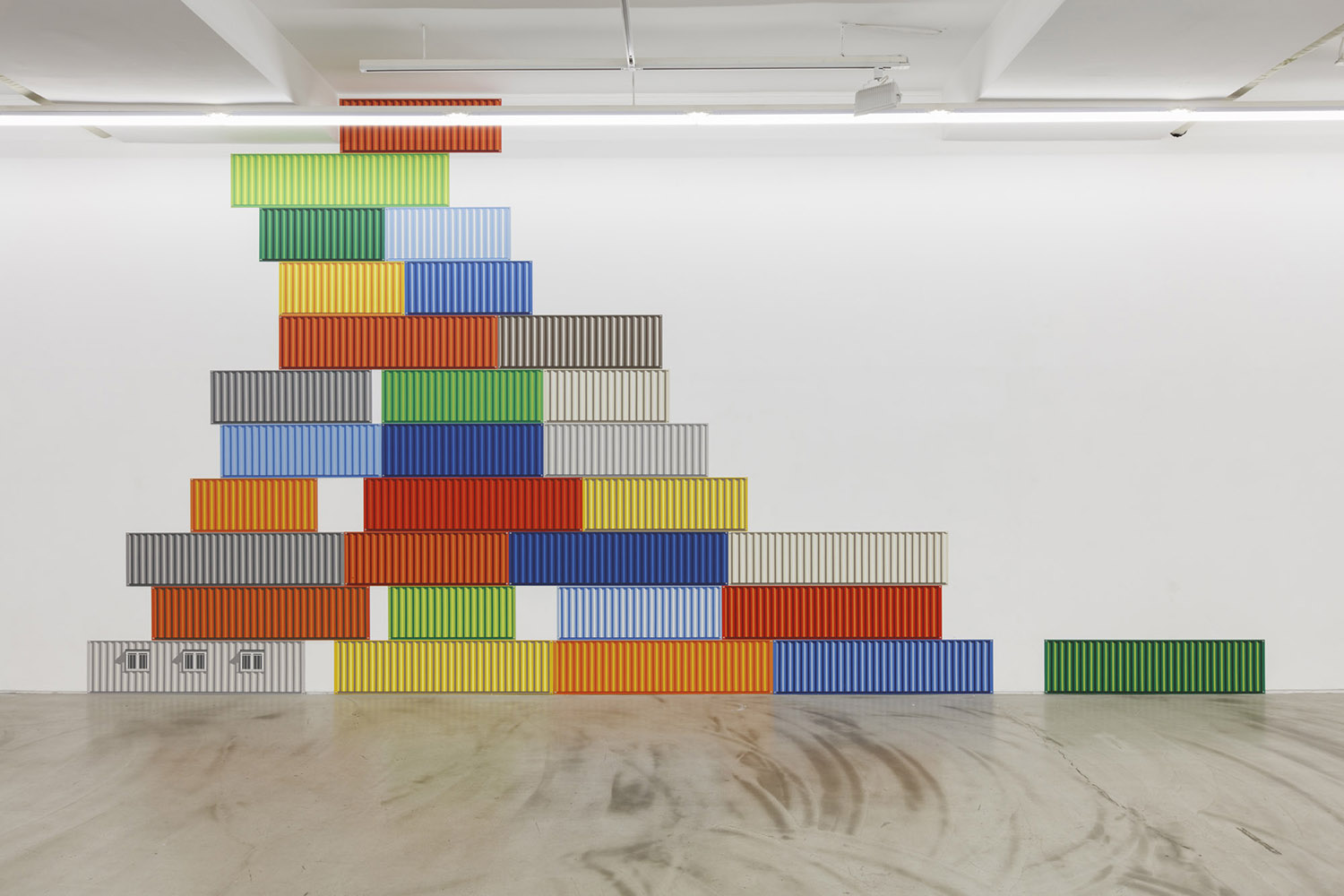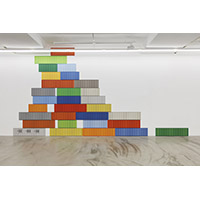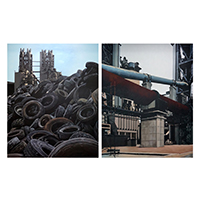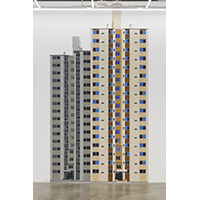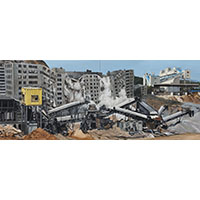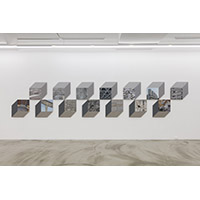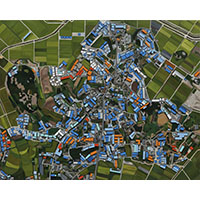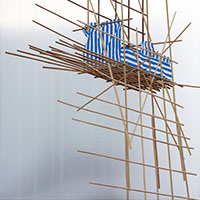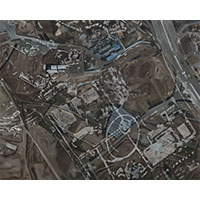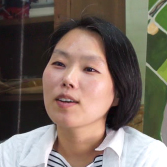
Jieun Kim, Blume Museum of Contemporary Art
Birth
1977, Seoul, South Korea
Genre
Painting, Installation
Homepage
A New Sense of Painting a City: On KIM Ji Eun’s Painting
In Kim Ji Eun’s work, a city is both
an object of research and an organism responding to the ever-changing reality.
The city’s variable ‘state’ which is impossible to be captured in a single
scene is placed at the heart of the painting planned by Kim. She paints a city,
not as a sort of vague reverie but as the reality of concrete life, with the
concrete evidences of the space that she watched and observed in person. The
time-space which Kim calls the ‘margins’ has been marked by repetitive
constructions, demolitions, and sudden appearances of a new space and
therefore, in itself bears witness to the history of Korean construction
industry that has shaped the land of Korea. Kim’s paintings investigate and ask
about the present picture of Korea’s compressed modernization which has been
reflected on the ups and downs of concrete buildings. By observing a city, she
puts up the textures and states of walls and the ground on the canvas in a
three-dimensional way. And to highlight their three-dimensionality, she
introduces various materials, such as self adhesive vinyl and tarpaulin covers,
in her work. Her sense of dealing with materials is extraordinary. By
incorporating readymade materials marked by materiality in her two-dimensional
works, the artist plays illusionism more easily, effectively, and masterfully.
Let us look at her high-rise apartment buildings, tinted in gray and ivory and
made up of self adhesive vinyl sheets(Inside
out-Concrete, 2016). Only using vertical and horizontal lines and grids
dryly, not overwhelmed by emotions, it presents the architectural ‘façade’ of the aesthetics of cold city that is under constant
construction and destruction. Although this urbanscape, not standing in profile
but frontal, may seem to sublime a moment monumentally and pictorially,
ironically, Kim knows intuitively and by research that all these urbanscapes
are ruins, about to collapse.
The term ‘paint’ used in the above paragraph needs to be more delicately
defined. When she converts the landscapes that she experienced and discovered
in various places of many cities and Byeokje, Goyang-si, using her unique
visual language, she puts forward flatness that creates visual illusion as the
process of ‘construction’. For the artist, to paint a city is not a matter of
expression, but a study based on the process of ‘creating’ by her own logic and
orderly ‘arrangement.’ Above all, it is very important procedure to research
the history of and the visual pattern found in the place where high-rise
concrete apartment buildings, temporary constructions, etc. are too easily
destroyed and rebuilt according to the logic of capital which is symbolized by
reality. It is in the context of studying the material features of concrete
which has spread over the time-space of the real world that Kim’s paintings
acquire physical three-dimensionality. The
Life Cycle of Concrete (2016) shows the moment of partial demolition of a
gray building, together with a temporary structure and heaps of earth on the
front and another buildings, not yet reaching the end of their lifespan, on the
back. To develop an inner logic by investigating ‘what to paint’ in the actual
time-space is of great importance to the artist. Through painting, she presents
the landscapes of the architectural beauty and high-speed capitalism of the
city and country she is living in, and macroscopic and microscopic views of
those who are living in a city, which is for her a creation of important visual
environment.
On the other hand, as is suggested by the fact that the artist used self
adhesive vinyl sheets on plastic corrugated sheets in Inside out-Concrete and created images using self adhesive vinyl on
aluminum sheet in Versatile Container Project (2016), her choice of readymade
materials, not brushes, for her two-dimensional work is very meaningful.
Aluminum sheets, adhesive vinyl, tarpaulin fabric, etc. are common construction
materials, composing temporary and instant landscapes of a city, which you
could often fine on the streets. This provides a clue to how Kim’s paintings
build a close relationship with the real architecture, the real urbanscape. Suspicious Roofs (2016) in which she
painted bird-views of roofs as small color planes on the canvas woven with
camouflage patterned waterproof fabric, and which shows and abstract geometric
pattern viewed on the Google map and from the camera mounted on the drone,
usually pointed vertically towards the ground, is and exact and unpresented
capture of a city which exists online and offline today. What scenes before her
eyes do this disorderly and repetitive appearance of concrete blocks and the
transformation of construction materials into ruins persuade Kim to paint?
Probably, Kim would be an artist who gave the sharpest answer to this question
in this year, and who creates the ‘point of time’ of question, for she never
gives up facing the front and represents the world in terms of the drone and
internet surveillance. For her, the city is not a subject matter, but in
itself, a foundation of painting. For the purpose of laying this foundation
firmly, Kim solidifies the groundwork, far from giving illusionistic
representation of walls or the ground or bustlingly looking for other themes
and narratives. Suspicious Roofsdisplays on the exhibition hall independently exist as separate fragments, not
as a connected image. How can we confront the image of a city which is
experienced through machines, such as the camera and the internet, with our
real body, real eyes, and real feet? On the “Capricious Land,” the title of her
solo exhibition held not long ago, Kim creates paintings which make us reflect
on the land and visual construction. And these paintings have gathered and are
creating another city that will survive very long.
HYUN Seewon (Curator, co-director of AVP)
Law-Full Landscape
There is a funny story about a curator who got hired temporarily in a governmental organization. Finding a green piece of felt placed under the glass on his desk, he removed it, which caused her to be thrown out by his colleagues. Though we see them always used by public officials, you wouldn’t be able to answer questions why and for what specific reason such stationeries as the felt board or green rubber board with scales drawn on it take the form as they are. The same goes with the typography or design of various notices or warnings issued from public institutions. Such products or papers which seem to have been manufactured to meet a budget limit only suffice a minimal usability and functionality. These objects, that must have been mass-produced at a low price in accordance with a unit cost provided by the Supply Administration, look ironically anachronistic in the age of design revolution. Or rather, they could be seen as products reminiscent of the past or as retro-kitsch in this time when taste of consumers is so much diversified. Their simple shape and old materials and, above all, the combination of absurd elements in such products irritate and confound our sense of beauty. Taking a close look at the shape and usage of such products, they seem to be physically manifesting a whole body of rules and systems, of which rigid and intimidating form and texture inflict instruction and discipline on us like the kind of huge monument looming over us only with its volume and scale that Chinese curator Wu Hung has indicated in Monumentality in Early Chinese Art and Architecture. Seen from this light, the curator in the story above deserved to be cornered alone for defying against the monumentality of the felt board that had been preserved so long!
Works of Kim Ji-eun start from a close examination of public designs on the street – a design in its general meaning–which are easily overlooked and examine into them to find out true identity of the objects. It was a dustproof drape installed to block the dust on the construction site that first caught her attention. It used to be of muddy gray tone in the past, but changed into bright stripe pattern without prior notice. The artist came to realize that there were enforced regulations of clean air act in the laws of the Ministry of Environment, behind the newly decorated drape traversing the city. At the same time, the drape recalled the artist of rainbow-colored rice cake favored at baby’s birthday party, or with some sort of minimalistic artwork, or the works by Christo. Her paintings and texts, in this understanding, are keeping observation and sharp examination of the city and ontological, epistemological study of art at the same time.
This exhibition is like a report on the status of ‘public art’ in a sense that it takes a scrupulous research on how mechanism of visual literacy is constituted and operated as visual experience in everyday life. The young artist digs into the course of how the current “awkward” position of contemporary art in today’s market has been incurred when the public art of today turns out to be no more than a struggle over commercial advantage between artists and big firms, or internal dispute among artists over the profit from public sculpture whose presence is conserved by “Enforcement Ordinance of the Law for the Promotion of Culture and Art.” Her works make us think on the series of questions of what contemporary art could be in the marketplace or in a harsh reality. The artist and her imagination deal with various ordinances and regulations using texts; actual objects as externalization of them; images as the copy of them. We have a totally different living environment depending on how the artist or her imagination deals with them. The form or positioning of architecture, particular material or texture of soundproof devices, or the way in which the branches of trees on the street are trimmed, all of these are the results of the institutional intervention, and they look overly rigid. Yellow line patterns on the street, public signage, or even a pole in the sky are results of such intervention and mediation as well, and they look almost omnipresent.
We often forget that we are in a way artificial products controlled by several variables. Kim Ji-eun, in her first solo exhibition, tries to point out that such seemingly unnatural regularities are in fact flexible and are actually reflect no more than the institutional ideology. Artists today expose the rigidity and ubiquitous invasion of institution into everyday life by intentionally make them ‘leak’ from the gaps slit open by the intervention of artists.
Baik, Ji Sook (Insa Art Space Director)
In search of Human in the City
During the installation period of ARTSPECTRUM 2012, Ji Eun Kim Climbed on a scissor lift every day to work on her art. To be more precise, when the museum began construction in the gallery, Kim started creating her own. She spent almost a month constructing a prototype scaffold by arranging fish cake sticks on a 4-metre-high fake building wall; and she climbed on the lift every day to create a collage of a 12-metre watchtower on a wall of the exhibition hall. As such, Kim came every day to the construction site – full of dust and loud noise – to create her two works, Mass of Scaffolding and Some Watchtower. Both are based on a ladder or lattice structure. The scaffold and the watchtower share a similar basic design, and their construction in this case required the artist to climb repeatedly up and down in a lift. Ji Eun Kim’s current works are situated cleverly on this shared point of contact: the necessity of gaining vertical height against gravity.
Scaffolding: Lifting High
A scaffolding is a temporary structure used extensively for the purposes of construction. Kim’s interest in particular objects from construction sites is far from unexpected, as her main themes are taken from urban architecture. More surprisingly, however, the very first time she looked carefully at a scaffolding was in Hong Kong, the city of high-rise skyscrapers. The scaffoldings used on Hong Kong’s construction sites are made from natural materials, namely bamboo trees. For Kim, accustomed to the metal scaffolding seen on construction sites around the globe, the bamboo structures between high-tech skyscrapers in Hong Kong offered a dramatic contrast, as if an element from some primitive age had been transported into this otherwise futuristic city. At the sight of such unique scenery, the artist abruptly realized that even the tallest and most spectacular buildings are built by human hands.
Although Kim has explored numerous construction sites, it was only recently that scaffolding caught her attention. Scaffolding is absolutely necessary as a means of hoisting architecture of various sizes to a vertical position above the ground; simply put, construction workers must ascend in order to create a building. Until this point, Kim’s work had treated humans as the residents of a city: the users of complete buildings and inhabitants of a fully articulated environment. However, her encounter with scaffolding motivated her also to reflect upon the people involved in the construction process. Once a building is complete, its scaffolding is demolished – as are the traces of human labor from the history of the building. By installing scaffolding – with all that it suggests of inescapable eventual elimination – in a gallery setting, Kim attempts to restore to public view the efforts of the workers and the traces of their hard labor.
In order to create the prototype scaffolding entitled Bigye Dungori (Mass of Scaffolding), Kim diligently layered fish cake sticks and twist ties on a 4-metre-high surface seemingly taken from the mirrored wall of a high-rise building. Bigye Dungori is also the Korean title of of the famous short story ‘Boule de Suif’ (‘Butterball’ or ‘Ball of Fat’) by the late-nineteenth-century French writer Guy de Maupassant. Here, the word Bigye (‘fat’) borrows from Korean phonetics in order to play on words. A scaffolding structure is destined never to become a complete or permanent piece of architecture, even if it is well constructed and aesthetically pleasing. Although not necessarily the artist’s intention, the merely functional role of scaffolding can be fruitfully compared with the situation of the prostitute Boule de Suif, who receives no respect from the other travellers in Maupassant’s story. Kim’s scaffolding, artfully installed on a sparkling mirrored surface, is her means of denying the inherent limitations of the structure, and of reconsidering the human effort that has disappeared ‘behind the scenes’ in creating the spectacle.
Kim’s scaffolding has a powerful ambivalence. The memory of human labor is all too frequently lost to the city; only ultra high-rise buildings remain, endlessly produced as part of the city’s spectacle. Like a caterpillar that shakes free its skin to transform itself entirely into a butterfly with splendid wings, buildings shed their scaffolding and are reborn with a glittering, smooth exterior, forming part of a spectacular urban landscape that in turn perpetuates the desire for more spectacles. Made of a sheet of mirror-finished film, the beauty of Kim’s scaffolding reflects upon our unconditional desire for fashion, glamour and exterior spectacle in urban architecture, and draws our attention to the human effort that lies behind such spectacles.
Watchtower: Climbing Up High
The reason Ji Eun Kim climbed so diligently up and down in a lift was to build a watchtower. Like that of a scaffold, the concept of a watchtower guarantees height. The watchtower installed on the tallest wall of Leeum’s Ground Gallery originally did not exist only in image. The artist gathered abandoned pieces of wood, plant sprigs and garbage from the area surrounding her current home, Nanji Residency (in Seoul), and wove them together to create a prototype watchtower. Although initially ragged in appearance, this prototype was transformed and expanded to a strong, sturdy, 12-metre-high collage on the gallery wall. A watchtower has the clear and self-sufficient purpose of looking down at the ground from up high. Kim’s watchtower, however, is not designed for surveillance. The people who climb up her tower will be our ‘Chilsu and Mansu’ (protagonists of a Korean play/movie, characterized as weak citizens) and the residents evicted from Sangam-dong and Yongsan: all second-class citizens within our society.
In the winter of 2011, Kim moved into the Nanji Residency, which is run by Seoul Museum of Art. For the first time, she faced the island of Nanjido – once Seoul’s official dump site, and a by-product of rough-and-ready industrialization – and experienced first-hand the scars on the landscape and the ongoing process of healing the site. The area has been rehabilitated to create such new, spectacular environments as the World Cup stadium and Digital Media City. Underneath this newly rebuilt area, however, lies an ‘in situ’ work of art, in the artist’s own words, as the vertical flow of history has been totally covered up by the spectacles. From her proximity to Nanjido, Kim learned about Seoul’s forgotten history, the voices of its people vanishing behind the glamour of the city. And on their behalf, she began thinking about her work Some Watchtower.
The interactive artistic process of climbing high up in a lift to add collaged images of a watchtower to the exhibition wall is a suggestive homage to the socially weak, who are in need of a place to express their opinions, their own watchtower. Originally made with abandoned material, Some Watchtower, now existing only in image, is an ‘anti-monumental monument’ to the socially deprived. In other words, this watchtower is not the ‘Panopticon’ (designed by Jeremy Bentham) for the sole purpose of surveillance; rather, this watchtower was built for the weak, by the weak. Kim’s watchtower reflects the social participation of middle-class citizens who cheer sheepishly but whole-heartedly from behind the scenes, and refers to the artist’s sense of her vocation as a social imperative.
And the Artist
Yearning for a higher place is a long-cherished desire for humans, whose feet are destined to remain on the ground. Even in today’s urban environment, ‘height’ has become a condition of socio-economic status or leadership (hegemony), making it a desire that city people cannot disregard. Scaffoldings and watchtowers are both vertical structures that realize the human desire for gaining height against gravity. Although the two objects seem utterly dissimilar, they are, interestingly, often seen in the same space, slightly staggered. Sangam-dong was one such space, and so was Yongsan. And due to socio-economic associations, people who climb up a watchtower have a greater likelihood of climbing scaffolding for a living. Reading such codes from the city of Seoul, Ji Eun Kim looks carefully at the vertical environment of this city: scaffolding at construction sites enabling construction workers to ascend in order to create the buildings for money; and watchtowers to spread the voices of the socially weak. Sympathizing with both sets of individuals – construction workers and the socially deprived – Kim created her own scaffolding and watchtower in order to pay tribute to their actions and their existence. In the earlier stages of her career, Kim based her work chiefly on the rules and referents provided by buildings. While her early works are about reading flat structured matrices, a definitive element of a city’s physical structure, her current works – focusing on the vertical elements of the city – seek to comprehend the human lives that fill up the empty spaces of these lattices. And Kim leaves the traces of her own labor on her exhibition spaces to signal her respect for the socially deprived.
Tae Hyunsun (Senior Curator, Samsung Museum of Art LEEUM)
Planned Obsolescence
The intent of Ji-Eun Kim’s work conveys an absolutely singular intensity. She works as a visual artist whose critical observation and analysis of the system of her environs – which she’s both lived and seen – resonate the sense of its own, internal logic in her art, as well as carries the sense of her own lived experience therein. In a way, she might also be said to look at those places she sees with the calculating eyes of an urban planner, but also as a comparative anthropologist or sociologist might imagine.
An installation that looks like a construction site, situated amidst the process of building a house, currently occupies the entire rear corridor and the two sidewalls of the exhibition space of Brain Factory and is particularly alluring for its depth and dimensionality. This installation, entitled “Model of Planned Obsolescence,” resembles a construction site for suburban homes in the United States. Inside the construction site, architectural skeletons of a future home are represented through collages of trompe-l’oeil prints. One instantiation, a collage depicting or resembling slanted roofs, staircases that lead up to another floor, a series of timber that supports the ceiling and more, contributes to the feeling of looking at the practice of perspective applied by Italian Renaissance artists, such as Piero della Francesca, Paolo Uccello, and Andrea Mantegna. On the exterior of Kim’s installation of the rear corridor, printed images of the repeated English letters “Tyvek” are prevalent, obviously in reference to the “Tyvek” trademark that is used as a “housewrap,” the mark of construction sites in-progress. Indeed, even beyond the primary site, structures like a black dumpster and a blue portable toilet appear alongside the sidewalls, which further emphasize the work-in-progress of the obsolescent home.
But why would Kim represent a suburban home-construction site of the U.S. in the middle of an alternative exhibition space in Seoul, South Korea? At a first glance, you might think that the artist enjoyed recreating an illusory space, employing perspective technique as well as physically composing the collage out of materially heterogeneous mediums. However, once you look into the installation more closely, it is a sort of critique by way of visual representation of very specific phenomena that the artist directly observed while living in the U.S.
As the title of the exhibition suggests, “Planned Obsolescence” exemplifies the causes and the result of suburbanization and de-urbanization that has spread steadily throughout the U.S. and remained omnipresent in home-construction since World War II. Like the reproduced and standardized products consumed in capitalist society, house-building has become – indeed appeared as – another of convenience of consumerism, especially insofar as “homes” are sometimes built with entirely pre-fabricated elements produced in a single factory. The image of that polyethylene “Tyvek” material in Kim’s work symbolizes this exterior, entirely superficial layer of consumption that distinctively marks this phenomenon.
Between 1946 and 1951, real estate developers William and Alfred Levitt began developing pre-fabricated homes for veterans returning from World War II who desperately needed inexpensive housing. A town comprised of such “pre-obsolescent homes” – if I may say – was first built on Long Island, New York, and called “Levittown.” This simple, even “assembly-line” construction of post-war homes proceeded to expand throughout the burgeoning suburbia of the United States during the fifties. These houses’ mode of production developed due to the economic pragmatism prevalent in the times and these homes were not to meant to last more than thirty years. Such principles were and continue to be based on a form of consumerism that anticipates obsolescence, but which vastly differed from home-construction in the past, something which sought permanence in quality and aesthetic variety.
Furthermore, the geographical expansion of suburbia by realtors, who sought empty plots where building regulations were less strict, also contributed to de-urbanization insofar as people left the cities for dreams of their own homes in more spacious, cleaner areas. The most extreme example is perhaps the birthplace of the automobile industry, Detroit, where only poor African-Americans who couldn’t afford a car and house were forced to remain in the city while everyone else left. In this fashion, Detroit and several other prominent U.S. cities quickly became blighted by drugs, violence and crime, and thus became some of the most undesirable and most dangerous places to live. Kim even lived in Detroit area between 2007 and 2009, and her work testifies to the continuing effects of this abhorrent phenomenon.
Pre-fabricated homes inspired by fiscal efficacy and suburban expansion can historically be thought of as contributing to the recent economic recession in the U.S. Along with the implosion of the housing bubble, bankruptcy for those individuals who couldn’t afford to pay their mortgage, and the bankruptcy of formerly credible financial institutions and creditors contributed to a worldwide recession, the likes of which have not been seen since the Great Depression. In some ways, it would not be much of a stretch to say that the current economic collapse stems from the myopic attitudes of this fundamentally consumerist psychology, seeking the most convenient, cheapest and efficacious as the best solution.
Kim’s installation work, “Model of Planned Obsolescence” delivers something beyond the pleasure of seeing the trompe l’oeil collage in the perspective of the viewer. Through this work, we are forced to think about the problems entailed in the notions of “development” and “efficiency.” Her current work continues to build upon her previous interests in subjects broached before she went to the U.S. – such as the urban planning environment of Seoul that is managed and controlled by regulations – and provides even the casual visitor with an opportunity to reflect upon our own situation via the comparative cultures of dwelling and architectures which the artist has represented from her direct experience thereof.
Hyewon Yi






